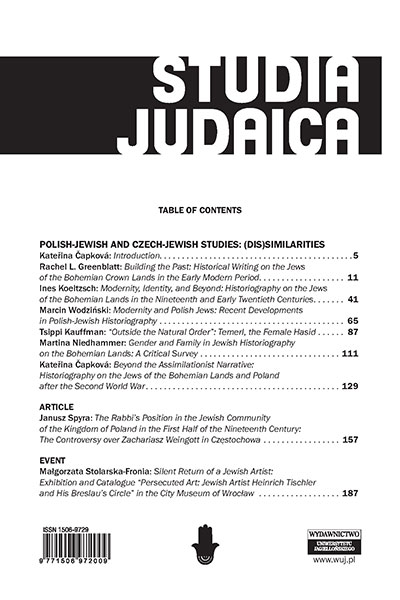
We kindly inform you that, as long as the subject affiliation of our 300.000+ articles is in progress, you might get unsufficient or no results on your third level or second level search. In this case, please broaden your search criteria.

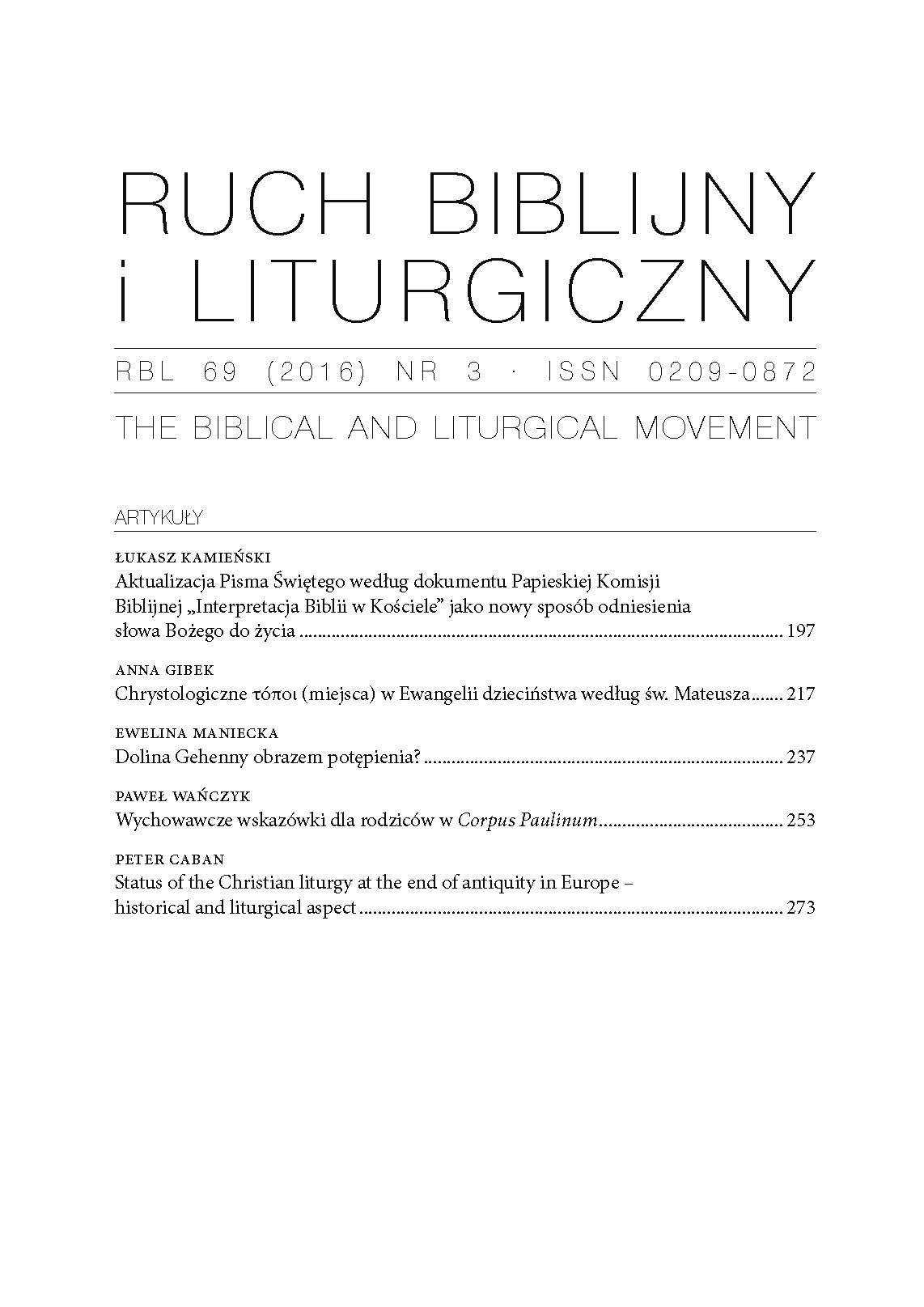
Review of: BOGDAN PONIŻY - S. ELŻBIETA NATANAELA ZWIJACZ OSU, Obraz ludu Bożego według Księgi Liczb, Wydawnictwo Naukowe Uniwersytetu Papieskiego Jana Pawła II w Krakowie, Kraków 2010, 417 s.
More...
In Judaism, the study is a religious duty, because the pious Jew's life is governed by the requirements of the Torah. Therefore, Judaism is a religion of the book, of the study of the Scriptures. This explains the organization of a Hebrew educational system at all levels, in all times and in all the places inhabited by Jews, as one of the major concerns of any community, illiteracy being almost unknown. The same happened in the Jewish community in Arad, one of the representative communities of Transylvania where, in time, there were various Jewish educational institutions, both religious and secular: elementary school, high school, Torah Talmud or yeshiva.
More...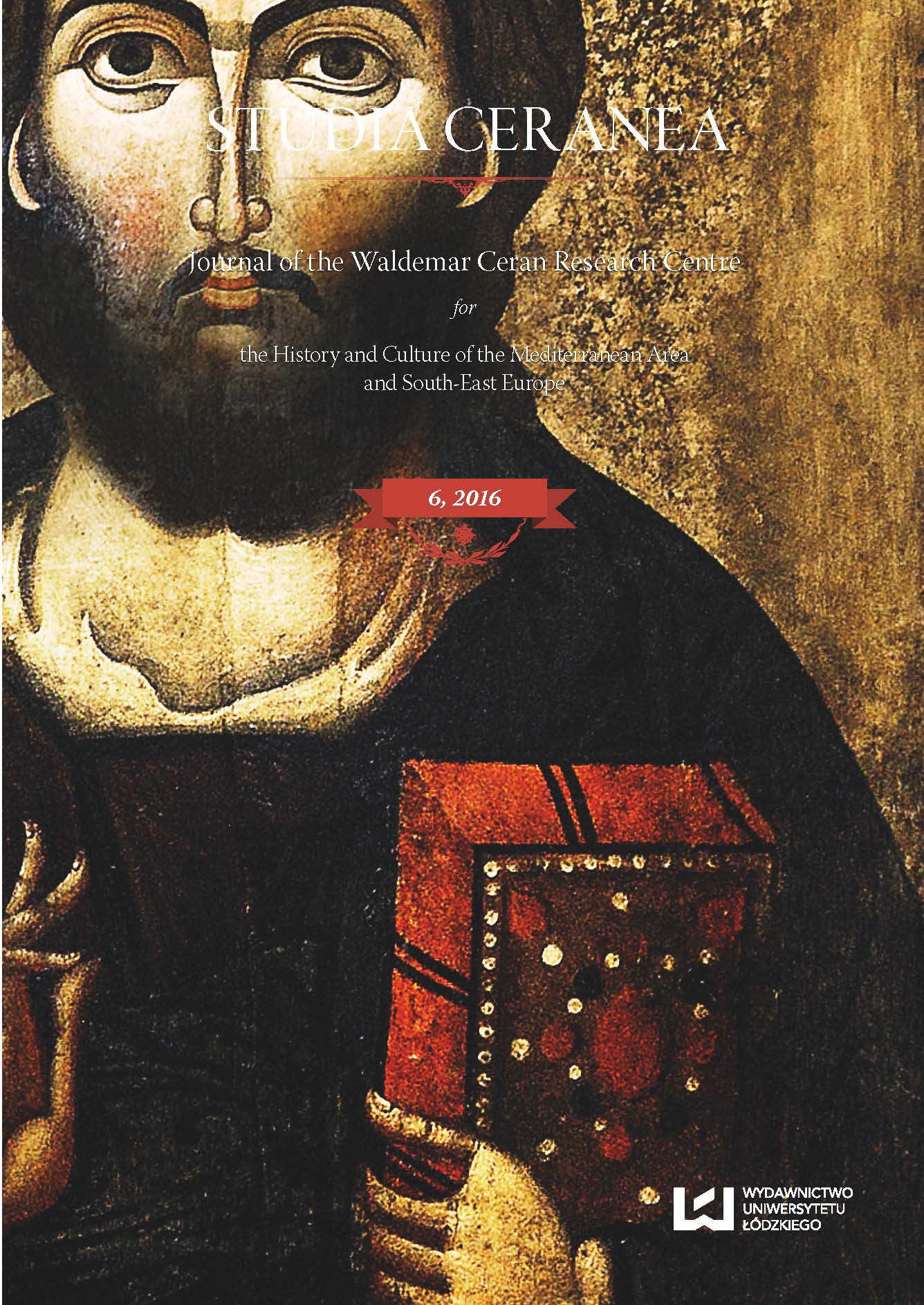
A sermon attributed to Theodore Syncellus (Theodoros Synkellos) is considered as one of the basic sources for the study of the Avar siege of Constantinople in AD 626. Therefore, the most historians paid more attention to the analysis of its historical background than to its ideological content. From the ideological point of view, the document serves as an evidence that a fear for the future of the Empire and its capital Constantinople began to rise within emerging Byzantine society. The Avar siege served its author mainly as a model for developing his polemics with imaginary Jewish opponents and their religion. It deserves to be included in a long succession of similar polemical treatises, which have existed in Christianity from its earliest times.
More...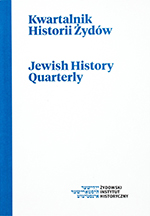
The predictions made by Kraków’s astrologers around the end of the 15th century constitute a treasure trove of information on daily life. One important topic raised in these unique prints were astrological forecasts addressed to various minorities, including Jews. Interestingly, a vast majority of these forecasts were not favourable to the followers of the Judaic faith, which must have been due to the air of ambivalence then pervading the Jews-Christians relations. Therefore the forecasts reflected the public mood then prevailing, the horoscopes produced on a mass scale becoming a weapon in this „propaganda warfare”.
More...
The source materials for the text are Warsaw newspapers of various political hues and local government periodicals. Due to the status of the capital city, the elections to the local government, while overshadowed by the parliamentary elections, were of exceptional importance for the young state. Their results aroused broad interests and elicited commentaries in the press. The author presents chronologically the results of the successive elections and the composition of the special administration, analysing the composition of the council of the city of Warsaw and naming representatives of local Jewish communities elected to that council based on democratic electoral regulations. She also mentions the voting pacts being formed in the local government forum. Special attention was paid to the last election, held in 1938, whose results were favourable to Bund, with quotes from writers interpreting that outcome. Appended to the article is a list of councillors representing Jewish milieux and parties, elected for each term.
More...
Individual and collective violence was an inseparable element of the exercise of power by the Third Reich in the occupied lands in East-Central Europe, both in relation to the Jewish population and other ethnic groups. Despite the that the Reich’s leadership took a lot of effort to create an illusion about the occupation order having the characteristics of the rule of law, the widespread violence applied to the subjugated populations and the Jews in particular meant that any civilizational and cultural norms were broken all the time and the brutalization of daily life proceeded unabated. Violence became an integral part of the system of exercising power, directing and driving the German occupier’s policy toward the Jewish population at all decision-making levels. With its help the German national socialists were building a new system of moral references, justifying the treatment of the hated minority in a manner far exceeding the rules of live in a society upheld so far. From the point of view of the perpetrators themselves this system made it possible to find ever further reaching rationale of their own active involvement in the implementation of that policy, and it convinced them about its indispensability for the success of the Nazi utopia. The use of massive violence ultimately became a sine qua non of the implementation of the utopian final solution of the “Jewish question” through genocide. This was a factor shaping a new system of moral values, cementing the sense of co-dependence of the perpetrators in a peculiarly defined “community of crime,” a vessel making it possible to transform utopian goals of the state into very tangible personal profits. Without the daily use of violence that overcame the still existing psychological barriers and suppressed any internal resistance the Holocaust just could not occur in the first place.
More...
The article looks at the shifts in the number of Jews in Russian between 1989 and 2010, both in the context of demographic changes of other ethnic groups and of regional distribution of such shifts. The huge swings in the number of Russian Jews in the period in question chiefly follow from mass migrations, which already began toward the end of the existence of the Soviet Union. Another factor contributing to the changes in numbers is assimilation and the ensuing change of ethnic self-identification. Between 1989 and 2010 the number of Jews in Russia shrank by more than 70%. No other ethnic group inhabiting Russia experienced an equally spectacular change. A huge question mark is hanging over the future of the Jewish diaspora in Russia due to the continued erosion of their numbers as a result of the migrations, a distorted population age structure (more than a half of the persons are over 60) and the very low average number of children in a family which does not guarantee even a simple demographic renewal.
More...
The Jewish Population’s Health Care Association, better known by its Polish acronym TOZ, was established in 1920. It engaged in actions aimed at improving the sanitary and hygienic standards of the Jewish population by means of setting up physical education institutions and facilities, providing medical care to children and youth, and combating communicable diseases taking a toll on the Jewish population. The Association had its branches in many towns. The one in Kraków was established in 1927. This article looks at its history until the outbreak of World War II. It examines the mechanism of its operation, scope of activity and the area where its presence was felt. The analyses made are based on source materials from the collections of the National Archives in Kraków and the archives of the Jewish Historical Institute in Warsaw, leaflets and information appearing in the press at the time. They warrant the assertion that the branch fulfilled its aims by providing sanitary and medical assistance to Jewish as well as non-Jewish inhabitants of Kraków.
More...
The author looks at the findings of research concerning the Jewish community in Gniezno, which appeared in Polish historiography of the town in the Middle Ages. He presents the beginnings of Jewish settlement in the Wielkopolska (Greater Poland) settlement area and presents hypotheses related to the question of the community inhabited by the group. The article also reviews problems connected with the legal status of Gniezno’s Jewish community and the Jews’ relations with Christians. The article also addresses the suggestions appearing in literature dealing with the subject aimed at determining the approximate number of Jews in Gniezno at the threshold of the early modern period.
More...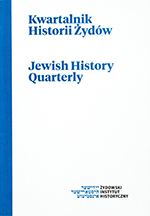
Mały Przegląd is a supplement to the Polish-language Jewish daily Nasz Przegląd. It is a specific settlement because it is made up of letters and texts by young readers and reporters. Many aspects of the pre-war daily life, the world in which the children lived, are presented here differently than in journals addressed to the grown-ups and in publications for children written by professional writers. Palestine, too, is different than the country one could read about in other Jewish periodicals: a country—one of many—that you go to, but often also return, where oranges indeed grow as promised but there is also unemployment, where the women go not so much to work in the pardes (orchards), but as cooks, or simply looking for a husband. Where young boys do not go to work in kibbutzim but to learn in a good secondary school in Tel Aviv. The Shomers do not always ride with a song upon their lips sing but often with a longing for the families left behin. In other words, realism prevails over idealism, helping the reader to learn about some aspects of emigration that have been little known so far.
More...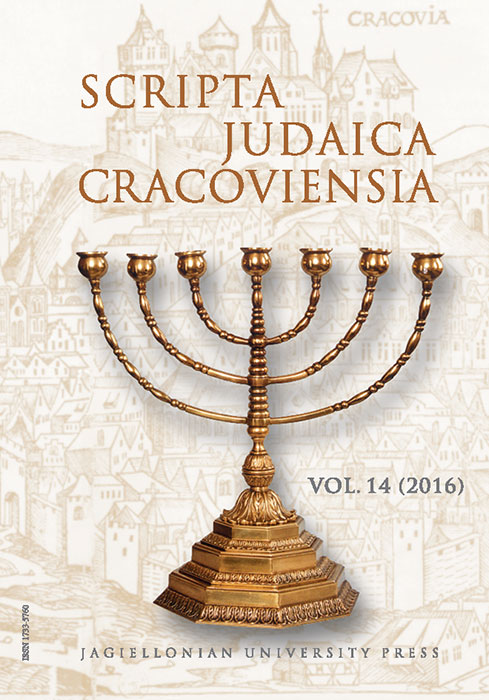
This article explores Josephus’s account of Seleucid history in Antiquities 13.365-371. In this passage, Josephus focuses on the Seleucid monarchs Seleucus VI, Demetrius III, and Antiochus X Eusebes and their fight for control of Syria. The difficulty in understanding this section is that it interrupts Josephus’s narrative of the reign of Alexander Jannaeus and does not fully explain events in Syria that led to the endless civil wars there. Through the use of historical and numismatic data unavailable to Josephus, this study examines the background of the Seleucid rulers to explain why their struggle was important for understanding Hasmonean history. Josephus begins this section on Seleucid history with Seleucus VI because his death created the political instability that led to a prolonged civil war between the remaining sons of Grypus (Antiochus XI Philadelphus, Philip I Epiphanes, Demetrius III, and Antiochus XII Dionysus) and the son of Antiochus IX Cyzicenus (Antiochus X Eusebes). For Josephus, this conflict was important since the fraternal civil war between these rulers led to the dissolution of the Seleucid Empire and its takeover by the Romans: a fate shared by the Hasmonean state. By placing this account of Seleucid history in his narrative of Jannaeus’s reign, Josephus uses events in Syria to foreshadow the fraternal strife in the Hasmonean state that likewise made it vulnerable to the Roman legions of Pompey.
More...
In this paper, I argue that the coins of the Jewish war of 66-70 C.E. demonstrate the theocratic conception of the Zealots and of the faction of Simon bar Giora. They are designed as responses to Roman issues and, therefore, are influenced by Roman currency. This minting is a powerful affirmation of independence for a so-called Jewish “State.” The divisions into several factions make it impossible to recognize a unanimous conception of what the political system among the Jews must have been. However, each coin seems to support the theocratic ideal, focalized either on the temple of Jerusalem or on the redemption of the people.
More...
There is no scholarly discussion on the impact of the Barbarian invasions on the Jewish communities of Roman Italy. Roman Italy fell victim to a series of invasions. First the invasion of Alaric’s Visigoths in 410 C.E., and then that of Genseric’s Vandals in 455 C.E., which culminated in the sack of Rome. These were followed by the establishment of the Roman-Barbaric Kingdom of the Ostrogoths, and the subsequent disastrous Gothic War (535-554 C.E.), which brought Italy back under Justinian’s rule. The Barbarian conquest of Italy ended with the Lombard invasion in the second half of the sixth century, around 568 C.E.The purpose of this article, therefore, is to demonstrate that the Barbarian invasions brought profound changes to the geographic distribution and the demographic development of the Jews living in Late Antique Italy. Thus, a close look at epigraphic data shows that the destruction that came in the wake of the Barbarian invasions probably resulted in the total destruction of the various Jewish communities established in northern Italy, and a substantial decrease, even decline in the Jewish population of Rome, sacked twice by the Barbarians during the fifth century, and much damaged by Justinian’s Gothic wars in the middle of the sixth century. On the other hand, it is possible to observe a slow demographic and geographic increase, albeit one that is difficult to measure, of the Jews living in southern Italy. This part of the peninsula suffered much less damage than the rest of the peninsula as a consequence of the Barbarian invasions, as attested in the epigraphic evidence from Venosa. Thus, by the end of the Barbarian invasions, the geographical distribution of the Jewish communities in southern Italy anticipated that of the early Middle Ages, attested in the eighth and ninth centuries C.E.The research leading to these results received funding from the European Research Council under the European Union’s Seventh Framework Programme (FP/2007-2013) / ERC Grant Agreement no. 614 424. It was part of the ERC Judaism and Rome, and was realized within the framework of the CNRS and Aix-Marseille University, UMR 7297 TDMAM (Aix-en-Provence).
More...
This article contains a brief description of the Codex of Petrarch, which is located in the Czartoryski Library in Kraków. Preliminary analysis proves that the Codex comes from Italy or France. The Czartoryski family bought it in the nineteenth century. The Petrarch Codex contains two incomplete biblical books: Genesis 23:8 – Exodus 14:28, i.e. Hebrew text and Aramaic translation. The analysis is focused on three main aspects: historical, paleographical and linguistics. The detailed analysis proved that the Aramaic text was in some aspects very similar to Targum Onkelos, and in others it was very similar to Targum Pseudo-Jonathan. Most importantly, the text contains an unknown version of Targum Onkelos. Therefore the article also shows morphological and grammatical differences between the official edition of the Targum Onkelos and the text.
More...
The article presents the activities of a preacher and teacher Szymon Dankowicz (1834-1910). In the 1860s Dankowicz was active in progressive circles in Warsaw. He had bonds with several institutions such as the Warsaw Rabbinic Seminary, the Lomdei Torah association, and the salon of the young Jewish intelligentsia; he also published in two Polish-Jewish periodicals Jutrzenka and Izraelita. In 1865 he unsuccessfully applied for the preacher position in the Daniłowiczowska Street synagogue. After 1868 he served as a preacher in the Kraków progressive synagogue. There he delivered sermons in the Polish language and manifested his pro-Polish attitude. In this city he also developed extensive pedagogical and charitable work. In later years Dankowicz applied for a preacher position at the Tempel in Lviv (1890) and served for several years in the Tarnopol Tempel (1895-1898). His biography, especially when compared to the biographies of other preachers, is an important example of the activities of a progressive preacher in partitioned Polish lands.
More...![An Annotated Translation of Pinchas Szerman’s Poilishe Khazones in Fargangenheitun Tzukunft, [The Polish Cantorate in the Past and the Future,] 1924](/api/image/getissuecoverimage?id=picture_2016_34436.jpg)
A translation of a Polemic essay by Cantor Pinchas Szerman, second cantor at the Great synagogue of Warsaw. The essay discusses the many difficulties experienced by cantors in his time, especially the ones who had not be educated. In Szerman’s opinion, the only way to ease the burden – especially the financial burden – was to create a class of educated and professional cantors. The many customs of Polish Jewry that are forgotten today have been annotated as well as basic biographical data on highly influential earlier cantorial masters
More...
The article is devoted to the phenomenon of radical assimilation in the late 19th century. The author focuses on the Markusfeld family, who had lived in Kraków since at least the mid-18th century. The study is an attempt to show the history of family against the background of the history of Galicia, in the second half of the 19th century, when the idea of integration was finally abandoned, and integration ceased to be seen as solution of “the Jewish question.” The paper is based on Bauman’s analysis of the general sociological mechanisms of modern assimilatory processes, and refers to the category of radical assimilation (T. Endelman). It seeks to answer the question of why most family members chose to convert at the end of the 19th century. The author shows that the choice of “default” religion, “universal” values, and “right” idiom was not tantamount to their affirmation – but it was a way to look for happiness and fulfillment, which was (unlike in France), according to some Jews not accessible while staying Jewish. Baptism was also a form of protection – the Second World War would prove it effective.
More...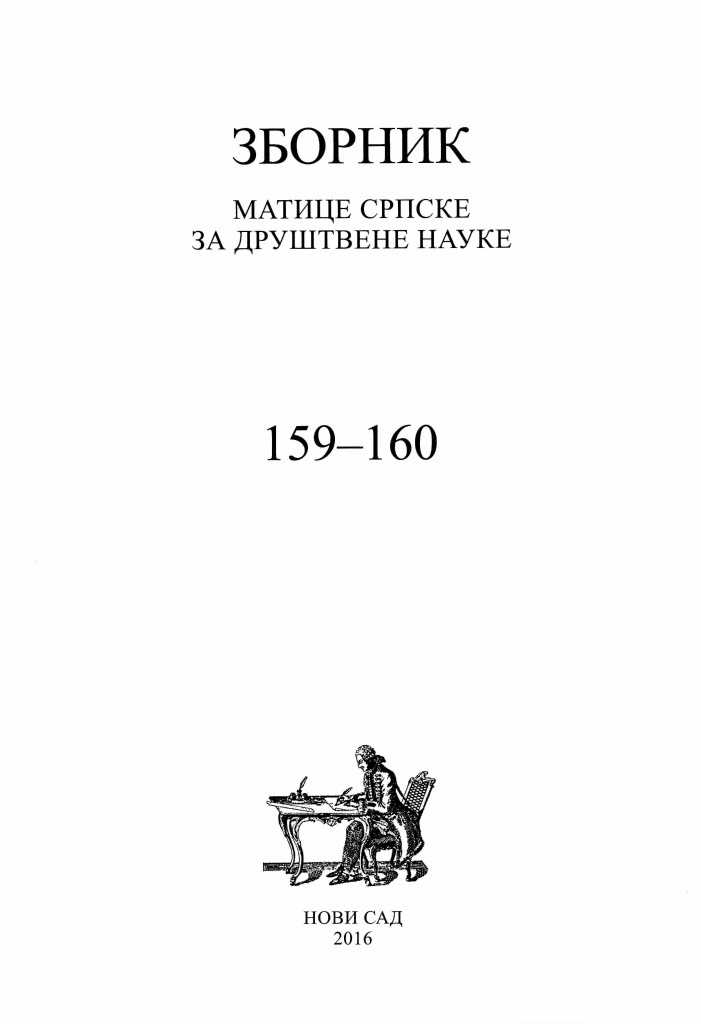
In 1492, Sephardic population was expelled from Spain, which spurred a great migration and caused them to seek refuge in other countries. One of these places of refuge was the city of Niš. Having arrived in the city on the Nišava River, a new phase of life for Sephardim began in the 17th century. They slowly built their society, taking a good care of their culture, language, customs, traditions, religion, in a word, of their ethnic identity. In this regard, the objective of this paper is to point to the existence and importance of a small community of Sephardic Jews in the city of Niš and its vital existence from the Turkish time until the beginning of World War II. This community was very active in the city, and it spawned great merchants, bankers, craftsmen, and individuals who participated in wars and thus helped local Serbian population. This community also invested in education of the youth and the creation of Jewish societies, whose role was to provide assistance to all members of the community. The desire for survival and creation was unshakeable, but inhumane events in 1941, when a large number of Jews were killed, stopped the Sephardic community in its intents and dealt a severe blow to this nation.
More...
This article studies the development of Jewish youth organizations in interwar Yugoslavia. Youth organizations were established all over the country with a task to bring the spirit of modernity into the Jewish community and stimulate the development of a national idea. Jewish community was particularly engaged in the field of sports, culture and preparation of youth for departure to Palestine.
More...